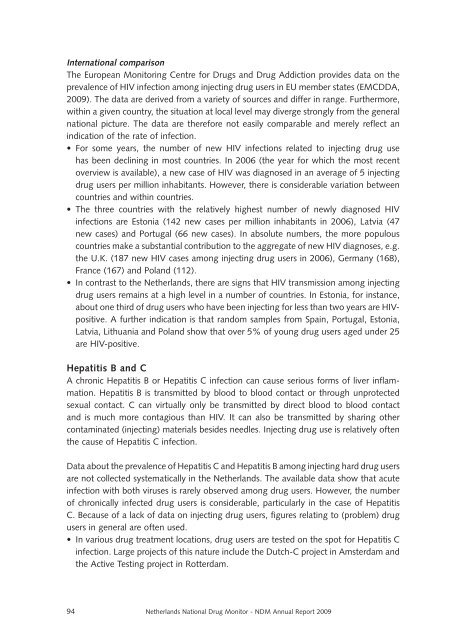Netherlands National Drug Monitor - Research and Documentation ...
Netherlands National Drug Monitor - Research and Documentation ...
Netherlands National Drug Monitor - Research and Documentation ...
You also want an ePaper? Increase the reach of your titles
YUMPU automatically turns print PDFs into web optimized ePapers that Google loves.
International comparison<br />
The European <strong>Monitor</strong>ing Centre for <strong>Drug</strong>s <strong>and</strong> <strong>Drug</strong> Addiction provides data on the<br />
prevalence of HIV infection among injecting drug users in EU member states (EMCDDA,<br />
2009). The data are derived from a variety of sources <strong>and</strong> differ in range. Furthermore,<br />
within a given country, the situation at local level may diverge strongly from the general<br />
national picture. The data are therefore not easily comparable <strong>and</strong> merely reflect an<br />
indication of the rate of infection.<br />
• For some years, the number of new HIV infections related to injecting drug use<br />
has been declining in most countries. In 2006 (the year for which the most recent<br />
overview is available), a new case of HIV was diagnosed in an average of 5 injecting<br />
drug users per million inhabitants. However, there is considerable variation between<br />
countries <strong>and</strong> within countries.<br />
• The three countries with the relatively highest number of newly diagnosed HIV<br />
infections are Estonia (142 new cases per million inhabitants in 2006), Latvia (47<br />
new cases) <strong>and</strong> Portugal (66 new cases). In absolute numbers, the more populous<br />
countries make a substantial contribution to the aggregate of new HIV diagnoses, e.g.<br />
the U.K. (187 new HIV cases among injecting drug users in 2006), Germany (168),<br />
France (167) <strong>and</strong> Pol<strong>and</strong> (112).<br />
• In contrast to the <strong>Netherl<strong>and</strong>s</strong>, there are signs that HIV transmission among injecting<br />
drug users remains at a high level in a number of countries. In Estonia, for instance,<br />
about one third of drug users who have been injecting for less than two years are HIVpositive.<br />
A further indication is that r<strong>and</strong>om samples from Spain, Portugal, Estonia,<br />
Latvia, Lithuania <strong>and</strong> Pol<strong>and</strong> show that over 5% of young drug users aged under 25<br />
are HIV-positive.<br />
Hepatitis B <strong>and</strong> C<br />
A chronic Hepatitis B or Hepatitis C infection can cause serious forms of liver inflammation.<br />
Hepatitis B is transmitted by blood to blood contact or through unprotected<br />
sexual contact. C can virtually only be transmitted by direct blood to blood contact<br />
<strong>and</strong> is much more contagious than HIV. It can also be transmitted by sharing other<br />
contaminated (injecting) materials besides needles. Injecting drug use is relatively often<br />
the cause of Hepatitis C infection.<br />
Data about the prevalence of Hepatitis C <strong>and</strong> Hepatitis B among injecting hard drug users<br />
are not collected systematically in the <strong>Netherl<strong>and</strong>s</strong>. The available data show that acute<br />
infection with both viruses is rarely observed among drug users. However, the number<br />
of chronically infected drug users is considerable, particularly in the case of Hepatitis<br />
C. Because of a lack of data on injecting drug users, figures relating to (problem) drug<br />
users in general are often used.<br />
• In various drug treatment locations, drug users are tested on the spot for Hepatitis C<br />
infection. Large projects of this nature include the Dutch-C project in Amsterdam <strong>and</strong><br />
the Active Testing project in Rotterdam.<br />
94 <strong>Netherl<strong>and</strong>s</strong> <strong>National</strong> <strong>Drug</strong> <strong>Monitor</strong> - NDM Annual Report 2009




